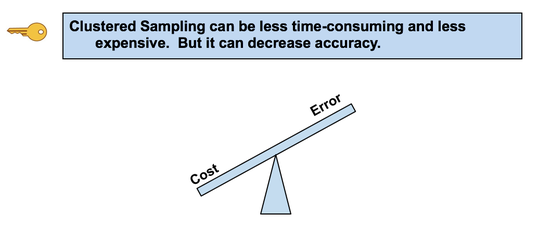|
Randomness is likely to be representative, and Simple Random Sampling (SRS) can often be the most effective way to achieve it. But in certain situations, other methods such as Systematic, Stratified, and Clustered Sampling may have an advantage. In our Tip of the Week for November 27, 2017, Stratified Sampling was described. This Tip is about Clustered Sampling. To perform Clustered Sampling,
Advantage: It can be less time-consuming and less expensive. For example, the Population is the inhabitants of a city, and a cluster is a city block. We randomly select an SRS of city blocks.
There is less time and travel involved in traveling to a limited number of city blocks and then walking door to door, compared with traveling to more-widely-separated individuals all over the city. Also, one does not need a Sampling Frame listing all individuals, just all clusters. Disadvantage: The increased Variability due to between-cluster differences may reduce accuracy.
1 Comment
Great article! I wanted to express my gratitude for the informative piece on Clustered Sampling. It's fascinating to learn about the unique advantage it offers in terms of being less time-consuming and less expensive, particularly in situations involving large populations like city inhabitants. Your insights provide valuable alternatives to consider in sampling methods. Thank you for sharing your expertise!
Reply
Leave a Reply. |
AuthorAndrew A. (Andy) Jawlik is the author of the book, Statistics from A to Z -- Confusing Concepts Clarified, published by Wiley. Archives
March 2021
Categories |


 RSS Feed
RSS Feed